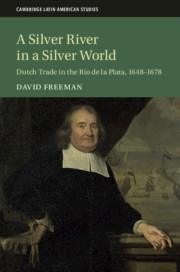Book contents
- A Silver River in a Silver World
- Cambridge Latin American Studies
- A Silver River in a Silver World
- Copyright page
- Dedication
- Contents
- Acknowledgments
- Maps
- Introduction
- 1 The Silver World
- 2 The Silver River
- 3 Golden Connections
- 4 Dutch Ships and Dutch Men on the Río de la Plata
- 5 Conflicting Ownership
- 6 Silver Tongues
- 7 Silver Politics on the Estuary
- 8 The Silver River Runs Dry
- Bibliography
- Index
- Series list continued from page ii
4 - Dutch Ships and Dutch Men on the Río de la Plata
Published online by Cambridge University Press: 18 April 2020
- A Silver River in a Silver World
- Cambridge Latin American Studies
- A Silver River in a Silver World
- Copyright page
- Dedication
- Contents
- Acknowledgments
- Maps
- Introduction
- 1 The Silver World
- 2 The Silver River
- 3 Golden Connections
- 4 Dutch Ships and Dutch Men on the Río de la Plata
- 5 Conflicting Ownership
- 6 Silver Tongues
- 7 Silver Politics on the Estuary
- 8 The Silver River Runs Dry
- Bibliography
- Index
- Series list continued from page ii
Summary
In the opening of the account of his voyages to the Río de la Plata, Acarete du Biscay described the ravages inflicted on Spanish ships returning from the Americas by the English during the Anglo-Spanish War (1654–1660). Du Biscay recounted how “their Cruisers hovering about Cadiz and San Lucar … intercepted some Ships coming from the Indies richly laden … and afterwards went to the Canaries, where they burnt most of the Flota that were arriv’d there from New Spain.” He then explained, “The Dutch who fought to make their advantage of the Troubles that the Spaniards were embroil’d in, sent several Ships to the River de la Plata, laden with Goods and Negroes, which they took in at Angola and Congo.” According to du Biscay, “the Inhabitants of the place [Buenos Aires] who had a long time been depriv’d of the Supplies which they had us’d to receive by the Spanish Gallions … and were beside in want of Negroes and other things” pleaded with the governor to allow trade. Consequently the Dutch found that, “the Governor [Baygorri], ... for a Present which they [the porteños] oblig’d the Hollanders to give him, and satisfying the Customs due to the King of Spain, ... were permitted to Land and Trade there.” A gift for the governor, taxes for the king, and goods for the merchants opened up a seaport supposedly closed to unlicensed ships.
- Type
- Chapter
- Information
- A Silver River in a Silver WorldDutch Trade in the Rio de la Plata, 1648–1678, pp. 86 - 114Publisher: Cambridge University PressPrint publication year: 2020

